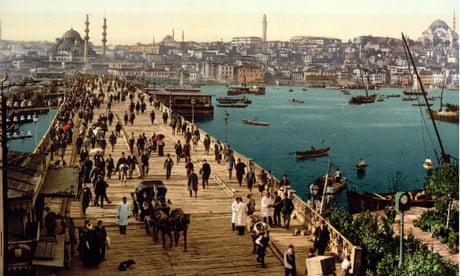This highly readable account encourages us to see the Ottoman empire as an inseparable part of the history of Europe

He even called himself caesar … Sultan Mehmed II, from the Sarayi Albums, c. 1480. Photograph: World History Archive/AlamyIan Black@ian_blackFri 22 Oct 2021 04.00 EDT
In May 1453, Ottoman military forces under Sultan Mehmed II captured the once great Byzantine capital of Constantinople, now Istanbul. It was a landmark moment. What was viewed as one of the greatest cities of Christendom, and described by the sultan as “the second Rome”, had fallen to Muslim conquerors. The sultan even called himself “caesar”.
After a lengthy siege, Mehmed rode his white horse to Hagia Sophia, the sixth-century Greek Orthodox Church of Divine Wisdom, at the time the largest building in the world. He ordered a single minaret to be added, turning it into a mosque, but refrained from remaking Constantinople as a purely Muslim city. Instead, he promoted the Sunni-dominated tolerance and diversity the Ottomans had been practising for more than a century in south-eastern Europe – long before European Christian societies tolerated their religious minorities. The new Ottoman ruling class was composed mostly of converted Christians.Advertisement
Marc David Baer’s core argument in this highly readable book is that more than 600 years of the Ottoman empire should be seen as an inseparable part of the history of Europe, and not as something detached from it, as with false narratives that paint the east and west, and Christianity and Islam, as antithetical.
Traditional European accounts of Ottoman rule tend to emphasise religion rather than secular matters in line with the significance attached to the Renaissance, the Reformation and the Enlightenment. But, as the author contends, “their story is the unacknowledged part of the story the West tells about itself.” At the peak of its power, this global empire governed nearly a quarter of Europe’s land area – modern Serbia, Bosnia, Hungary and Greece – and took in large chunks of the Middle East, including the Muslim holy places of Mecca, Medina, and Jerusalem, to north Africa.
The tale begins in the late 13th century with Osman, the eponymous founder of the Ottoman dynasty – a Muslim Turkic nomad who migrated, with herds of horses, oxen, goats and sheep, to Christian-majority Anatolia, then mainly Armenian or Greek. Osman’s son, Orhan, organised the first military units from prisoners captured in Christian-ruled areas. Conversion to Islam became a central feature of Ottoman life, as did the practice of fratricide – sultans killing their brothers to ensure a smooth succession – along with rebellions by “deviant dervishes”: radical Sufi Muslims.
Baer, professor of international history at the London School of Economics, defines the “Ottomans’ tripartite heritage” as “Byzantine-Roman, Turco-Mongol and Muslim” – and a “Eurasian amalgam”. The Ottomans became the biggest trading partner of western Europe in the Renaissance era. King Henry VIII of England enjoyed dressing in their fashionable styles. Suleiman I (who ruled 1520-1566), the first sultan to call himself “caliph”, fought the Persian Safavids in the east and the Habsburgs in the west.
This book is impressively well-structured. Chronological chapters focused on successive rulers are followed by thematic ones addressing cultural issues, messianic depictions of the sultan, the rise of the Ottomans as a maritime power and attitudes to women, Jews and eunuchs in dynastic politics.
Selim I’s conquests doubled the size of the empire, and by the end of the 16th century the Ottomans, Baer writes, “had reached the peak of their global political power and prosperity”. Decline set in following the failed siege of Vienna in 1683. Reasons for the defeat included the city’s sheer distance from Istanbul, the loss of Ottoman firepower superiority and the expansion of rival empires in central Europe. By the second half of the 18th century Russia had replaced the Safavids as the Ottomans’ principal enemy. And it was Tsar Nicholas I who referred to the empire, on the eve of the Crimean war, as “the sick man of Europe”.

Read moreAdvertisement
This “sick man” label became particularly fashionable during the 33-year reign of Sultan Abdulhamid II, who fuelled European outrage, and was known as the “red sultan” on account of his massacres of Armenians. He suspended parliament and sparked the rise of revolutionaries, called the Young Turks, who would erode Ottoman power. The outbreak of the first world war was followed in 1915 by the Armenian genocide.
A distinctly Ottoman version of orientalism played a role in administration of the shrinking empire, with the elite in Istanbul viewing itself as a civilising force over Arabs, Bedouins and Kurds – what one scholar wittily labelled “the white man’s burden wearing a fez”. Eventually, Turkish nationalism replaced Ottoman Muslim nationalism under Mustafa Kemal (Atatürk), who inaugurated a new language: modern Turkish, shorn of Arabic and Persian words, and written in Latin rather than in Arabic script. Kurds were viewed as “savages” in the new Turkish republic.
Memory matters: in 1918, the French general who entered Istanbul after the Allied victory was riding a white horse in a deliberately humiliating imitation of Mehmed II more than 450 years earlier. Baer’s fine book gives a panoramic and thought-provoking account of over half a millennium of Ottoman and – it now goes without saying – European history.
The Ottomans: Khans, Caesars and Caliphs is published by Basic (£30). To support the Guardian and Observer, order your copy at guardianbookshop.com.Delivery charges may apply.